Sign up for Lesson Plans, discounts & more!
The Permian Period:
The End of An Era
The Permian Period was a time of great change on earth. The climate, continents, and living things were all changing dramatically. This is also the time of the ancestors of mammals. It ended with the Great Dying, the greatest extinction ever!
The Permian is the final period of the Paleozoic Era. It began about 299 million years ago and lasted until 252 million years ago. The greatest mass extinction that has ever occurred on earth took place at the end of this 47-million-year period. Its name comes from a region of west-central Russia called Perm Oblast. This is where rocks from this time were first found.
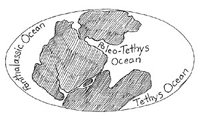
Pangea Is Now Complete
For most of the Permian, life on
Earth was much like it had been in the Carboniferous. Temperatures were
cooler because the continent of Pangea was moving northward.
Mountains were forming as the supercontinent Pangea moved. When the
continent of Siberia collided into the northern part of Euramerica,
Pangea was complete. The Ural Mountains were pushed up by this
collision.
Conditions Become Dry On Pangea
Pangea was shaped like a large “C.” It surrounded the Tethys Sea. The rest of the Earth was covered by a huge ocean named Panthalassa.
Even though the ocean covered much of the earth, Pangea was so large
that the interior did not benefit from the ocean waters. Deserts were
places in the center of Pangea where the temperatures changed from very
cold to very hot. In some places there was rarely or never any rain.
Over all the earth was dry during the Permian Period.
Plants Adapt To Dry Climate
The
swamp land dried up and many of the plants that needed the water died
out. New plants developed that were adapted to the dryer conditions.
They were called gymnosperms. These plants had seeds. One of the
earliest of these plants still exists today. It is called the Ginkgo. Most of the trees living during this time period were conifers. Conifers are trees with seeds in cones.
Another gymnosperm from this time was glossopteris. Glossopteris forests eventually covered much of southern Gondwana. They are famous as the fossils that helped to prove plate tectonics. They are found on South America, Australia, Africa, and Antarctica, continents that made up southern Gondwana.
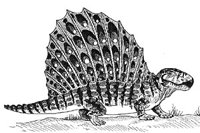
Check out some of the Educational Materials for sale on our sister site fossilicious.com.

The Dry Climate Favors The Reptiles
The changing climate
affected how animals were evolving also. Amphibians that had depended on
the swamps for a moist habitat began to die out. They were replaced by
the reptiles whose bodies could live in the very dry air and the wide
changes in temperature. Pelycosaurs evolved from their beginnings
in the Carboniferous. These animals look like a reptile, but have skull
characteristics that make them more like a mammal. The most famous of
the pelycosaurs is the Dimetrodon. Like many other pelycosaurs,
Dimetrodon had a large sail on its back. The sail could have been used
to help keep the body temperature stable.
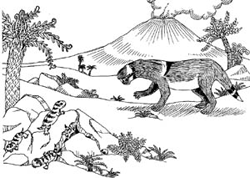
Therapsids developed during the Permian Period also. These animals are the ancestors of mammals and share some bone structure characteristics. Some of the therapsids from the Permian period may have had fur to help them adapt to the temperature changes.
Coral Reef Building
The
corals began to produce again in the Permian Period. After
near-extinction at the end of the Devonian period, corals were now
making huge reefs. Many corals did not survive the mass extinction that
came with the end of the Permian. The horn corals and tabulate
corals that had built many reefs in the Devonian period were all gone
after the Permian.
The End of The Permian Period
The corals were not the only species to become extinct. The Permian Extinction was largest mass extinction that had ever occurred. No extinction since has killed so much of the life on the planet. In the seas, 90 to 95 percent of the species went extinct or were severely harmed. On land the damage was less severe, but some species, like the pelycosuars, died out completely.
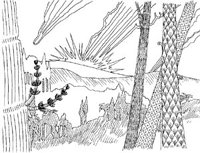
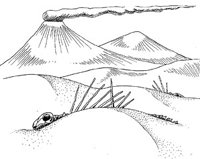
Mass Extinction Theories
Volcanic Activity
There are many theories about the cause of this great extinction. It could have been caused by huge amounts of volcanic activity, more than any that has been experienced since written history. We know from recent volcano eruptions that large eruptions can cause the temperature to drop all around the globe. In Siberia there is a place called the Siberian Traps. They were created by huge amounts of volcanic activity over millions of years. One estimate on the amount of lava from this time is equivalent to covering the entire United States 1 mile deep!
Recent studies of the area show that the eruptions caused underlying coal beds to ignite and burn. The resulting release of CO2 adding to the outpouring of gasses from the volcanos caused a major global warming event.
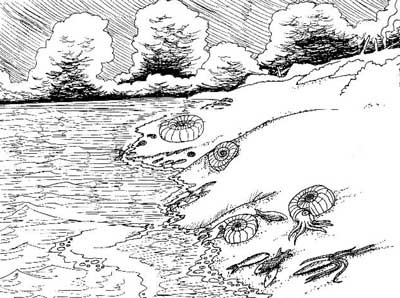
Comets and Meteors
Another theory is that a comet or meteor could have hit the planet, setting off a series of events that would have caused changes to temperature and sea levels, including the formation of glaciers. Others think that the formation of a land mass as huge as Pangea upset the balance of climate that happens when the ocean waters can affect more of the land surface.
No
matter what the cause, the extinction event that took place at the end
of the Permian Period was so important that it brought the end to the
Paleozoic Era. Life on Earth would never again look as it had during the
Paleozoic Era.
The next Period is The Triassic Period
Preceeding The Permian Period is The Carboniferous Period
interested in more? If so, you may want to check out our other sites:
fossilicious.com - Our online fossil and mineral rock shop.
rocksandminerals4u.com - An educational site about rocks, minerals, and geology.
Geologic Time Geologic Time Line
Cenozoic Era
Quaternary
Neogene
Paleogene
Mesozoic Era
Cretaceous
Jurassic
Triassic
Paleozoic Era
Permian
Carboniferous
Devonian
Silurian
Ordovician
Cambrian
Archean Time
Hadean Time
Teachers Resources
Activities for Education and Fun
Earth Science Lesson Plans
Activities For Kids
Fossil Lesson Plans
Fossil Activities
Education Articles
Coloring Pages
Dinosaur Coloring Pages
Montessori Materials
Geology Club
Fossil Hunting
 |
 |
 |




